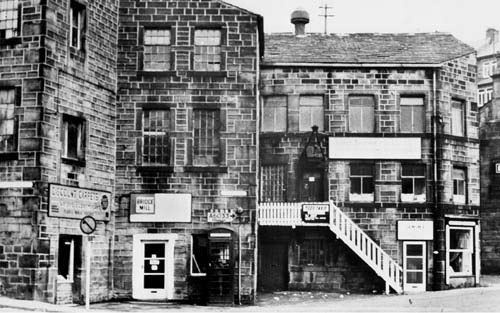Bridge Mill: History on our doorstep
Wednesday, 3 April 2013

Anyone who visits Hebden Bridge is immediately drawn to the atmospheric Bridge Mill, but few realise the richness of its history, with records stretching back 700 years. Local historian Justine Wyatt, with the support of the mill’s current owner David Fletcher, has uncovered more of the story of the building, and gave a fascinating talk to the Hebden Bridge Local History Society.
The water powered medieval corn mill would have been a timber framed thatched building where all the tenants of the lord of the manor were obliged to take their corn.
The court rolls of the manor of Wadsworth give some fascinating insights into the mill’s medieval past: one Stephen the Miller was named in many disputes, including some which accused him of cheating (which millers were often accused of doing) and the miller’s inability to prevent ‘the mill going away on account of the flood’ in 1336 will arouse sympathy in many Hebden Bridge shopkeepers today.
The milling and the disputes continued into the nineteenth century, with tenant Champion Murgatroyd fighting to protect his water courses and in turn being accused of adulterating the flour with allum.
The building was extended and rebuilt in stone, but was probably still a corn mill in 1860. But by 1871 there was a tall chimney for the steam powered cotton spinning. The most famous occupants of the mill in more modern times were clothing manufacturers Greenwood and Pickles, who attached a generator to the wheel to run their machines, and eventually to supply electric lighting.
When David Fletcher rescued the derelict Bridge Mill in 1973, a new phase began, and with the installation of a new wheel and the archimedes screw which will generate electricity, it will soon be water powered yet again. The story of Bridge Mill, as Justine pointed out, reflects the adaptability of local people and continues to be part of the social and economic life of the town.
Previously, on the HebWeb
Working from home in 1825; Working from home is not a new concept, Malcolm Heywood told members of the Hebden Bridge Local History Society. William Greenwood's described his several different occupations. Read more (20 March)
The Grave of Robin Hood: mysterious goings-on in Calderdale. Kai Roberts told the local history society about Robin Hood in Calderdale and especially the monument known as Robin Hood’s Grave. Read more (11 March)
Todmorden Weavers and the Great War. Alan Fowler, former lecturer in Economic and Social History, told a meeting of the Hebden Bridge Local History Society that the local Weavers’ Association had 4000 members at its peak. Read more (19 Feb)
Our Railway Station in the 19th century. David Taylor told a meeting of the Local History Society about how the early railway developed in Hebden Bridge. Read more (28 Jan)
Untold Stories: A glimpse into the lives of local people - Tony Wright has for the past ten years been collecting personal life stories on film and audio tape. Read more (18 Jan)
City in the Hills - Corinne McDonald and Ann Kilbey told a meeting of the Local History Society of Dawson City, the building of the Walshaw Dean Reservoirs and the publication of a new book. Read more (16 Dec)
Lament for the Mills - Robert Cockcroft, poet and academic told of his childhood spent close to mills owned and operated by his grandfather, John Cockcroft and his father, Keith. Read more (2 Dec)
How much thought do you give to a war memorial? - Mike Edwards told a meeting of the Local History Society, war memorials can be found in many forms and in unusual places. Read more (17 Nov)
Clubhouses: self help and co-operation - A small row of houses in Old Town, called Clubhouses, encapsulates some of the history and spirit of the Calder Valley explains Julie Cockburn. (30 October 2012)
Small Town Saturday Night - The story of a love affair with rock 'n roll at its peak in the 1950s and 60s from speaker Trevor Simpson.
The world of Cornelius Ashworth, speaker Alan Petford, Local History talk of 10 October 2012

